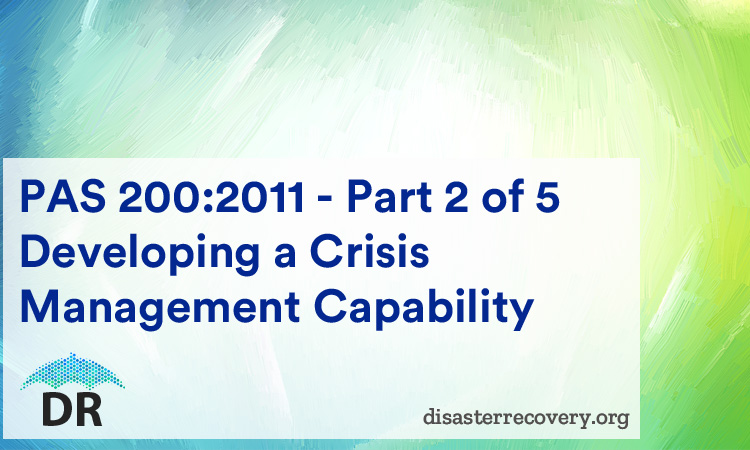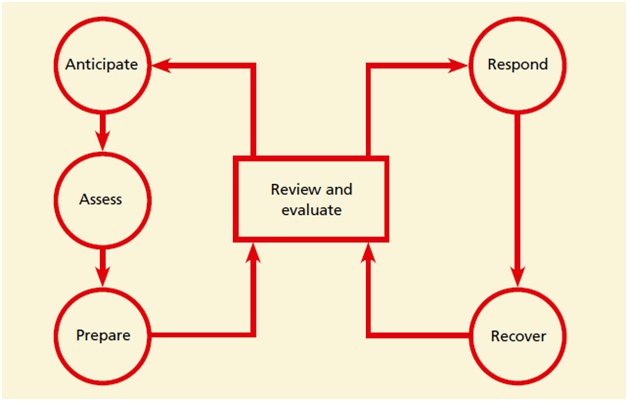An organization does not have to go through a crisis in order to develop a crisis management capability. The following image gives a general overview of the elements that contribute to effectively managing a crisis situation.
PAS 200:2011 - Part 2 of 5 Developing a Crisis Management Capability


Anticipation, assessment and preparation are iterative processes that can be achieved through:
- external management reviews
- periodic checks
- near misses
- exercises
- studying crises affecting other organizations
Reponses are relatively short term actions. Recovery measures span over a longer period of time. Both tasks provide valuable feedback that on review and evaluation can greatly improve the existing methodologies for anticipation, assessment and preparation.
The context¹ of a crisis management capability can be described by four main requirements:
- Intellectual requirement – situational analysis, strategy development, evaluating possible responses, decision making, and impact evaluation.
- Organizational requirement – a framework of systems and processes for converting blue prints into action
- Cultural requirement – the level of enthusiasm the employee personnel demonstrate in implementing managerial decisions
- Logistic requirement – mapping personnel abilities and skills to roles and responsibilities
Policy and Direction
- An organization’s policy towards developing a crisis management strategy should clearly define the main objectives and scope of the plan in accordance with the scale of its operations and the kind of business activities it engages in.
- Tasks should be prioritized based on operational criticality and bound by timeframes.
- It should also be compliant from a legal and regulatory perspective.
- Review mechanisms must be put in place to keep crisis management policies consistent with objectives over extended periods of time.
- Roles and responsibilities must be defined as per the crisis management requirements.
¹environment (in the broadest sense of the word) within which the organization seeks to achieve its objectives [BS 31100:2008, Risk management – Code of practice (modified)]
- Also, the required headcount, skill sets, expertise and competence must be adequately chalked out.
- Other factors to take into consideration are:
Mechanisms for horizon scanning² and vulnerability assessment create a consistent crisis management strategy. PAS does not make methodology related recommendations for horizon scanning or vulnerability assessment because of the following:
- Organizations differ in operational structure and approach. Horizon scanning and vulnerability assessment would largely depend on the specific factors at play in a business unit that might contribute to the outbreak of a crisis.
- Organizations should rather look to use existing issues management processes that take advantage of market intelligence to improve operational and qualitative efficiency and adapt them to their crisis management needs.
- An organization’s risk assessment and business impact analysis strategies can also be customized to cater to crisis management needs.
Information becomes a valuable asset during a crisis. So systems and procedures should be put in place to share, store, update and manage it efficiently in order to detect early symptoms of factors that might contribute to a crisis.
²systematic examination of potential threats, opportunities and future developments, which may have the potential to create new risks or change the character of risks already identified
³anticipation and assessment of trends and potential changes in an organization’s business environment, which entail forward planning to address opportunities and threats, and responding rapidly to issues that might threaten its reputation or relationships with stakeholders
Situational Awareness
In today’s highly competitive business world, where the margins for advantage can be minimal, responding to threats and taking advantage of opportunities often depends on the ability to make quick decisions in a rapidly changing environment that needs to be constantly observed. This constant monitoring on ones surroundings logically leads to a forecast of what might and might not happen along with the probability of the same.
Broadly termed as situational awareness , this activity should take every department’s point of view into account in order to arrive at an in depth assessment. Such a task would require time, effort and relevant tools. Two basic tools have been described below:
Situational Awareness
- What has changed? Assessing change involves classifying information into three categories –
- Reliable/accurate information
- Educated guesses/presumptions/unreliable information with a reasonable probability of being accurate
- No or lack of information
- What is happening? Identify how events differ from each other in terms of nature, scope, scale, rhythm and impact.
- What is changing? Anticipate the kind of information that hasn’t yet been uncovered.
- So what? Understand the criticality and significance of the events at play.
- What might happen? Forecast the following
- Short term, medium term and long term possible outcomes
- Best case to worst case possible scenarios in sequential order
⁴process of perceiving, comprehending, interpreting and evaluating what is happening in a crisis, combined with the ability to identify and model foreseeable future developments
Factorizing
This is an auxiliary tool that refines the procedure for achieving situational awareness by breaking down a problem or situation into its fundamental components. This allows an organization to better understand the possible consequences and repercussions involved. It is achieved through a methodology known as PESTEELO in which an issue is segregated into the following factors:
- P – Political
- E – Economic or Financial
- S – Social
- T – Technical
- E – Environmental
- E – Ethical
- L – Legal or Regulatory
- O – Organizational
- Scale – the extent to which an organization can be impacted by the issue
- Duration – the amount of time the issue is expected to last
- Impact – the severity of impact or damage an issue is likely to cause
- Interdependencies – people, processes, technology and infrastructure don’t function in silos but rather work in a continuous flux of interdependent tasks and workflows. Understanding interdependencies makes us more aware of possible butterfly and cascading effects a problem can have on business operations.
Common Recognized Information Picture
While this segregation oriented methodology is extremely useful for decision making, an organization should also have a consolidated viewpoint of the situation at hand in terms of:
Situational awareness is the foundation for generating a common recognized information picture (CRIP)⁵ report. This is a decision support mechanism that gives the crisis management plan an operational framework and provides the organization a variety of benefits:
- Provides formal documentation of the data collected during the situational awareness task. This eliminates biased or skewed decision making.
- Allows decision making after thoroughly assessing, verifying and grading a situation.
- Includes a statement of understanding that acknowledges the limitations of the knowledge the organization has at its disposal. This allows the management to avoid conflicting interpretations of the same information and make speedy and confident decisions in a given situation.
- Can be easily updated and adapted to changes in the business ecosystem and can cater to the documentation needs of a variety of purposes such as information sharing, archival purposes, decision making and so on.
- Logs the assessments and decisions made by the crisis management team over a period of time. This information is vital during official enquiries and legal activities that sometimes follow a crisis.
While situational awareness analyzes a problem from the perspective of each department or business unit, CRIP provides a pan-organization perspective of the same problem.
Hence CRIP calls for a multi-departmental information management cell that is well trained and possesses the expertise to gather relevant information. Reporting systems are efficient and have been adequately tested. Standard operating procedures are executed once the crisis management plan is put into action.
⁵statement of shared situational awareness and understanding, which is briefed to crisis decision makers and used as the accepted basis for auditable and defensible decisions
Management teams do encounter some operational constrains while generating a CRIP report, such as:
- time limitations
- lack of sufficient of detailed information
- inaccurate assessment of the kind of information to be collected
The amount of time, effort and resources dedicated to generating a CRIP report depends on the situation to be dealt with. Its purpose is to aid effective decision making during a crisis. Hence, organizations must ensure that generating CRIPs doesn’t become a time consuming process.
Initial CRIPs are usually brief and lack critical details as information availability during the initial stages of a crisis is scarce. But they still provide valuable inputs for the management team in the decision making process.
Subsequent CRIPs are developed when the crisis has gained considerably in momentum. These reports provide more detailed information as there is more data readily and easily available. Research and analysis becomes more plausible at this stage. However, the information needs of decision makers also tend to change due to the appearance of various new factors that influence their assessment of the situation. This is the main reason why CRIP as a tool does not have a generic template.
- Corporate/Departmental – Decisions that benefit the overall purpose of the organization might still be detrimental at the departmental level.
- Essential/Activities – Customers, stakeholders and the public in general look for visible assurances during a crisis that something is being done about the situation. Unfortunately, responding in the best possible manner to a crisis need not necessarily be easily perceivable which leads to tension and unrest.
- Short term/Long term – Long term benefits can expose a business procedure to more variable factors that could change over the course of time. Excessive emphasis on an organization’s short term benefits can make an organization lose its sense of direction and purpose in the long run.
- Speed/Accuracy – Crisis calls for quick decisions and immediate action owing to immense pressure from various quarters. Precise decisions largely depend on having accurate information at one’s disposal and collecting such information takes time.
- People/Things – The safety and security concerns of employees and staff can come into direct conflict with assets and infrastructure during a crisis.
- Over-reaction/Under-reaction – While a certain display of anxiety is normal and to be expected during a crisis situation, it can create panic and cause unnecessary tension. At the same time, an organization would not want to appear unaffected by the implications of a problem which could be interpreted as a lack of concern or interest in resolving the issue.
Dealing with crisis often involves making assumptions owing to a lack of clarity and adequate information. The following measures are recommended while dealing with assumptions that go into the decision making process during crisis management:
- Identify – The management should be aware of the assumptions that form the basis of their decision making process. This includes long established assumptions that the organization might consider “safe”.
- Describe explicitly – A detailed description of the assumption upon which the management team is basing its decision is essential as it prevents ambiguity at a later stage.
- Categorize – Assumptions should be classified in a sequential order based on how close they are to actual fact.
- Gauge its criticality – The significance of an assumption is directly proportional to the consequences and negative impact they can have on business.
- Problem/Solution – It is important to clearly understand if an assumption is connected to the problem or solution during a crisis.
- Test them – Subjecting assumptions to exhaustive quality tests can provide a wealth of valuable information that can aid in decision making.
- Record findings – Data collected while investigating assumptions should be archived and shared with the concerned personnel.
Crises have a way of testing the mettle of even the most well prepared emergency teams. Building situational awareness and archiving it in the form of a CRIP provides a qualitative, consistent and coherent approach to making decisions during crisis. Familiarizing employees with these approaches through simulations and scenario based exercises onsite also helps immensely. This way, an organization can ensure it is capable of responding comprehensively to an emergency, thereby safeguarding the interests of customers and stakeholders alike.

